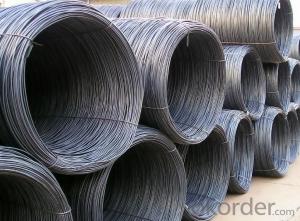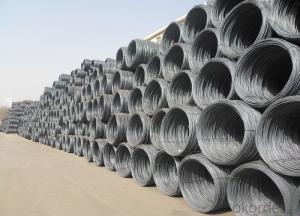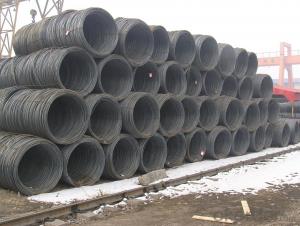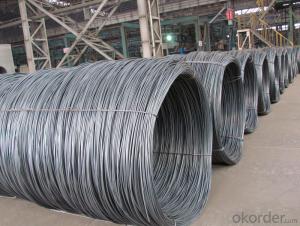Prime Metal Wire Rod in Low Carbon Packed in Coil
- Loading Port:
- China main port
- Payment Terms:
- TT OR LC
- Min Order Qty:
- 100 m.t.
- Supply Capability:
- 10000 m.t./month
OKorder Service Pledge
OKorder Financial Service
You Might Also Like
Item specifice
Product Description:
OKorder is offering Prime Metal Wire Rod in Low Carbon Packed in Coil at great prices with worldwide shipping. Our supplier is a world-class manufacturer of steel, with our products utilized the world over. OKorder annually supplies products to African, South American and Asian markets. We provide quotations within 24 hours of receiving an inquiry and guarantee competitive prices.
Product Applications:
Prime Metal Wire Rod in Low Carbon Packed in Coil are ideal for structural applications and are widely used in construction and manufacturing. Carbon steel wire rod is mainly used for reinforcement of reinforced concrete and welded structure or reprocessed (roberts , nail, etc.) materials, especially used to produce wire drawing, welding electrode, nails, spring, electronic, precise machinery parts and so on.
Product Advantages:
OKorder's Prime Metal Wire Rod in Low Carbon Packed in Coil are durable, strong, and wide variety of sizes.
Main Product Features:
· Premium quality
· Prompt delivery & seaworthy packing (30 days after receiving deposit)
· Can be recycled and reused
· Mill test certification
· Professional Service
· Competitive pricing
Product Specifications:
Manufacture: Hot rolled
Grade:SAE1006,SAE1008B
Certificates: ISO, SGS, BV, CIQ
Packaging: Export packing, nude packing, in coils, each coil around 2mt
Size: 5.5mm, 6.5mm, 8mm, 10mm
Grade | Chemical Composition(%) | |||||
C | Mn | Si | S | P | B | |
SAE1006B | 0.03~O.07 | ≤0.32 | ≤0.30 | ≤0.045 | ≤0.040 | >0.0008 |
Mechanical properties | ||||||
Yield strength(N/mm2) | Tensile strength(N/mm2) | Elongation(%) | ||||
250-280 | 350-380 | ≥32 | ||||
Grade | Chemical Composition(%) | |||||
C | Mn | Si | S | P | B | |
SAE1008B | 0.10max | 0.3~O.50 | 0.15max | 0.050max | 0.040 max | 0.0008 min |
Mechanical properties | ||||||
Yield strength(N/mm2) | Tensile strength(N/mm2) | Elongation(%) | ||||
FAQ:
Q1: Why buy Materials & Equipment from OKorder.com?
A1: All products offered byOKorder.com are carefully selected from China's most reliable manufacturing enterprises. Through its ISO certifications, OKorder.com adheres to the highest standards and a commitment to supply chain safety and customer satisfaction.
Q2: How do we guarantee the quality of our products?
A2: We have established an advanced quality management system which conducts strict quality tests at every step, from raw materials to the final product. At the same time, we provide extensive follow-up service assurances as required.
Q3: How soon can we receive the product after purchase?
A3: Within three days of placing an order, we will arrange production. The normal sizes with the normal grade can be produced within one month. The specific shipping date is dependent upon international and government factors, the delivery to international main port about 45-60days.
Images:
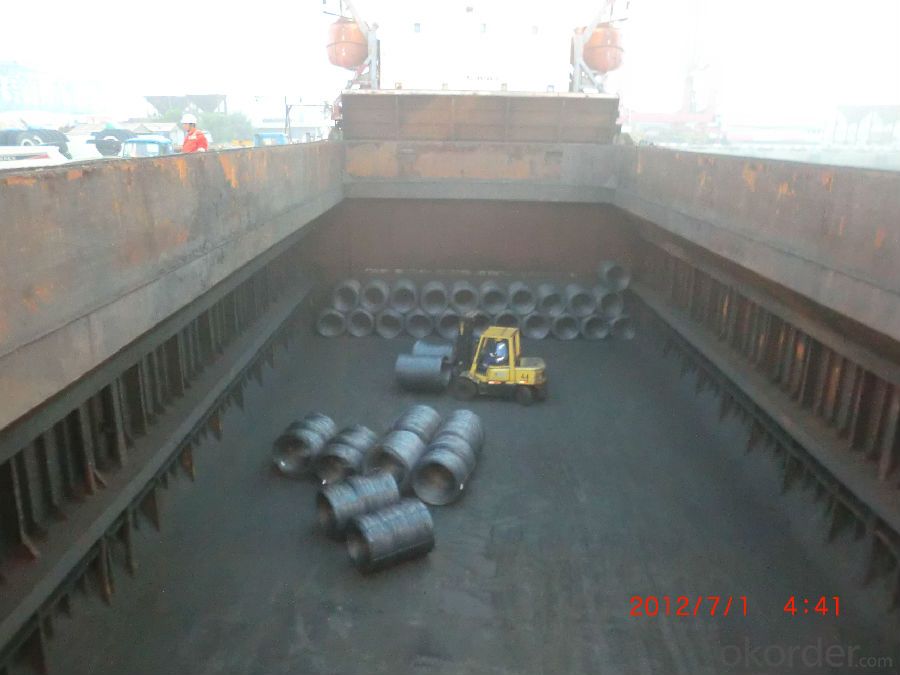
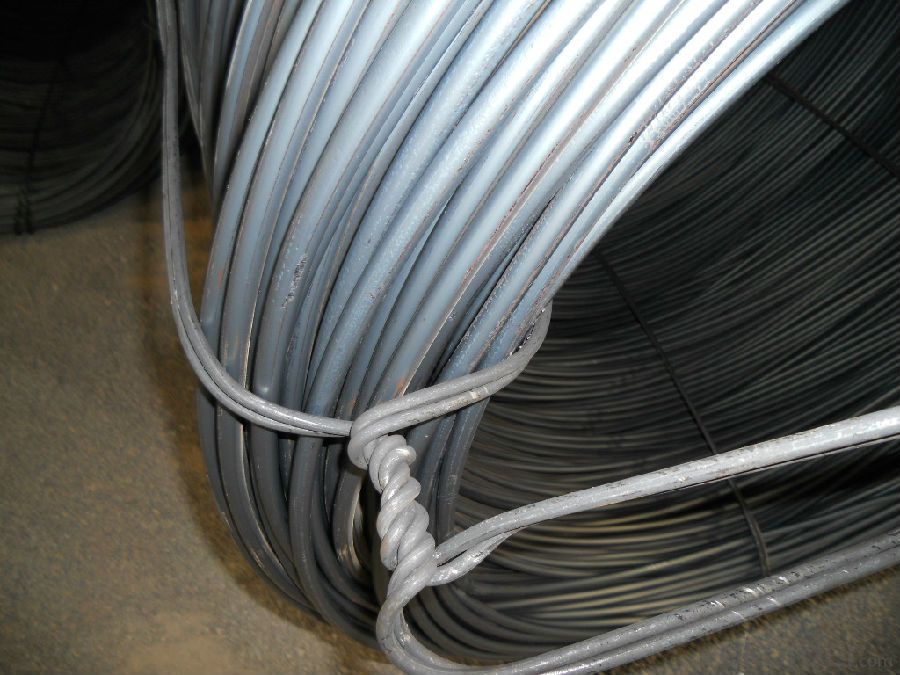
- Q:What are the different surface finishes available for steel wire rod?
- Some of the different surface finishes available for steel wire rod include black, galvanized, phosphated, and coated with zinc or other metallic coatings. These finishes serve various purposes such as corrosion resistance, improved appearance, and enhanced adhesion for further processing or applications.
- Q:How is steel wire rod used in the manufacturing of wire for electrical applications?
- Steel wire rod is used in the manufacturing of wire for electrical applications as it serves as the raw material for producing electrical wires. The steel wire rod is processed through various stages, such as drawing, annealing, and coating, to transform it into a high-quality and reliable wire that can conduct electricity effectively. This wire is then utilized in the production of electrical cables, wiring harnesses, and other electrical components, enabling the transmission of electricity in a safe and efficient manner.
- Q:What are the different sizes and diameters of steel wire rod?
- The sizes and diameters of steel wire rods vary depending on the specific application and industry requirements. Common sizes range from 5.5mm to 20mm in diameter, with some specialty rods available in larger sizes. However, it's important to note that these measurements can differ based on regional standards and customer preferences.
- Q:How is steel wire rod used in the manufacturing of wire for wind turbines?
- Steel wire rod is a crucial component in the manufacturing of wire for wind turbines as it forms the base material for making the wire. The wire rod is first processed through various stages, including drawing and annealing, to enhance its strength and flexibility. Once the wire is formed, it is utilized in wind turbine applications, such as the construction of electrical windings, cables, and structural components. The high tensile strength of steel wire rod ensures that the wire can withstand the demanding conditions within wind turbines, contributing to their overall efficiency and reliability.
- Q:How is steel wire rod used in the production of fencing?
- Steel wire rod is used in the production of fencing as the primary material for creating wire mesh, which is commonly used in various types of fencing. It is also used to reinforce and strengthen the structure of the fencing panels, ensuring durability and security.
- Q:What are the different sizes and dimensions available for steel wire rod?
- Different industrial and commercial applications can be accommodated with a range of sizes and dimensions for steel wire rods. The typical diameter of steel wire rods ranges from 5.5mm to 20mm, depending on the intended use. Length options commonly include 6 meters or 12 meters, but customized lengths are also possible based on specific requirements. Steel wire rods are measured by weight per unit length, which can vary according to the diameter and density of the steel used. To suit various applications, steel wire rods are manufactured with different levels of tensile strength, ranging from 500 MPa to 1,200 MPa. Surface finishes, such as bright, black, or galvanized, can be chosen based on the intended use and environmental conditions. It is important to note that availability of specific sizes and dimensions may differ among manufacturers and suppliers. Therefore, it is advisable to consult a trusted supplier or manufacturer to ensure that the required size and dimension of steel wire rod are available for a particular application.
- Q:What are the main factors influencing the choice of steel wire rod production process?
- Several key factors influence the selection of the steel wire rod production process. Firstly, the quality requirements of the final product play a vital role. Each production process has its own capabilities in producing steel wire rods with specific properties such as strength, ductility, and surface finish. The desired characteristics of the wire rod will determine the appropriate production process. Secondly, the cost-effectiveness of the production process is an important consideration. The overall cost of production can be significantly affected by factors like energy consumption, raw material utilization, and labor requirements. It is crucial to evaluate the efficiencies and costs of different processes to make the most economical choice. Moreover, the availability and cost of raw materials also impact the selection of the production process. Steel wire rods can be made from various types of steel, including carbon steel, alloy steel, or stainless steel. The choice of raw material depends on factors such as required mechanical properties, availability, and cost. The production process must be compatible with the chosen raw material. Another factor to consider is the production capacity and scalability of the process. Some processes are more suitable for small-scale production, while others are better suited for large-scale manufacturing. The desired production volume and scalability requirements must be taken into account to ensure the chosen process can meet the production demands. In addition, environmental considerations can also influence the choice of production process. Some processes may generate more waste or emit higher levels of pollutants compared to others. Companies may prioritize sustainable and environmentally friendly production methods, leading them to select a process that minimizes environmental impact. Overall, the selection of the steel wire rod production process is influenced by factors such as desired product quality, cost-effectiveness, availability and cost of raw materials, production capacity and scalability, and environmental considerations. A careful evaluation of these factors is necessary to choose the most suitable production process for a specific application.
- Q:What are the different types of surface defects that can occur in steel wire rod?
- Steel wire rods can experience various types of surface defects, which can have a significant impact on their quality and performance. Common surface defects include the presence of oxide layers, visible cracks, small depressions or cavities, loss of carbon from the surface layer, visible marks or lines, and thin layers or separations within the wire rod. Oxide layers, known as scale, form on the wire rod's surface due to the reaction between the steel and oxygen during manufacturing. Scale can negatively affect the wire rod's mechanical properties and surface finish. Visible cracks can occur on the wire rod's surface due to improper cooling, excessive rolling, or inadequate quality control measures. These cracks weaken the wire rod and reduce its durability. Pits, which are small depressions or cavities, can form on the wire rod's surface due to impurities or non-metallic inclusions in the steel. Pits affect the wire rod's surface finish and increase its susceptibility to corrosion. Decarburization refers to the loss of carbon from the wire rod's surface layer, often caused by improper heat treatment during the heating or cooling process. This reduction in carbon content reduces the wire rod's strength and hardness. Surface scratches, visible marks or lines, can occur during the handling, transportation, or processing of the wire rod. These scratches impact the wire rod's appearance and may lead to stress concentration points. Laminations, thin layers or separations within the wire rod, can form during the casting or rolling process. Improper rolling conditions or the presence of non-metallic inclusions cause these laminations. They weaken the wire rod and reduce its mechanical properties. To ensure the production of high-quality wire rods, manufacturers must implement effective quality control measures to detect and minimize these surface defects.
- Q:How is steel wire rod used in the production of wire mesh for animal enclosures?
- Steel wire rod is an essential element in manufacturing wire mesh for animal enclosures, as it serves as the primary material from which the wire mesh is formed. The wire rod, typically composed of low carbon steel, undergoes a series of processes to achieve the desired wire mesh. To begin, the steel wire rod is drawn through a set of dies to reduce its diameter and increase its length. This wire drawing process ensures that the wire rod possesses the appropriate thickness and strength required for its intended use in animal enclosures. Once the wire has been drawn, it is often galvanized to enhance its durability and resistance to corrosion. Galvanization entails immersing the wire in molten zinc, resulting in a protective zinc coating that effectively prevents rust and prolongs the lifespan of the wire mesh. Subsequently, the galvanized wire is either woven or welded together to form the wire mesh structure. Woven wire mesh is created by interlocking the wires in a crisscross pattern, resulting in a robust and flexible mesh. Conversely, welded wire mesh is fashioned by joining the wires together at their intersections, yielding a more rigid and stable mesh. The wire mesh produced from steel wire rod offers several benefits for animal enclosures. Its strength and durability enable it to withstand the impact and pressure exerted by animals, ensuring their safe containment. Additionally, the small gaps between the wires provide ventilation and visibility, allowing animals to see their surroundings while maintaining a secure enclosure. In conclusion, steel wire rod plays a crucial role in the production of wire mesh for animal enclosures, providing the necessary strength, durability, and security to create a safe and reliable enclosure for various types of animals.
- Q:What are the different corrosion testing methods for steel wire rod?
- Steel wire rods can be assessed for corrosion susceptibility and resistance using various testing methods. Commonly employed techniques include the Salt Spray Test, Electrochemical Corrosion Testing, Immersion Test, Humidity Test, Cyclic Corrosion Test, and Accelerated Corrosion Test. During the Salt Spray Test, the wire rods are placed in a chamber and continuously exposed to a corrosive salt spray mist. Visual inspection is then conducted to identify corrosion signs like rust or discoloration. Electrochemical Corrosion Testing involves immersing the wire rods in an electrolyte solution and applying a small electrical current to measure the corrosion rate. By analyzing polarization curves and other electrochemical parameters, the wire rods' corrosion resistance can be determined. The Immersion Test requires the wire rods to be submerged in a corrosive solution for a specified period. The type of corrosive solution used varies depending on the intended application or environmental conditions. After removal, the wire rods are inspected for corrosion signs such as pitting or surface degradation. To simulate the effects of high humidity, the wire rods are subjected to the Humidity Test. They are placed in a controlled humidity chamber where relative humidity is maintained at a specified level. Visual inspection is then conducted for surface oxidation or other corrosion indications. In the Cyclic Corrosion Test, the wire rods are exposed to alternating cycles of different corrosive environments. This includes salt spray, humidity, and dry conditions to mimic real-world situations. The test evaluates the wire rods' corrosion resistance under changing environmental conditions. Accelerated Corrosion Testing predicts the long-term performance of the wire rods by subjecting them to accelerated corrosion conditions. This can be achieved using accelerated corrosion chambers or electrochemical methods to speed up the corrosion process. Analyzing the corrosion rate and extent helps estimate the wire rods' performance in real-world applications. By utilizing these corrosion testing methods, valuable information regarding the corrosion resistance of steel wire rods can be obtained. This aids in making informed decisions regarding their suitability for various applications. The selection of an appropriate testing method depends on the specific requirements and environmental conditions that the wire rods will encounter.
1. Manufacturer Overview |
|
|---|---|
| Location | |
| Year Established | |
| Annual Output Value | |
| Main Markets | |
| Company Certifications | |
2. Manufacturer Certificates |
|
|---|---|
| a) Certification Name | |
| Range | |
| Reference | |
| Validity Period | |
3. Manufacturer Capability |
|
|---|---|
| a)Trade Capacity | |
| Nearest Port | |
| Export Percentage | |
| No.of Employees in Trade Department | |
| Language Spoken: | |
| b)Factory Information | |
| Factory Size: | |
| No. of Production Lines | |
| Contract Manufacturing | |
| Product Price Range | |
Send your message to us
Prime Metal Wire Rod in Low Carbon Packed in Coil
- Loading Port:
- China main port
- Payment Terms:
- TT OR LC
- Min Order Qty:
- 100 m.t.
- Supply Capability:
- 10000 m.t./month
OKorder Service Pledge
OKorder Financial Service
Similar products
New products
Hot products
Related keywords
